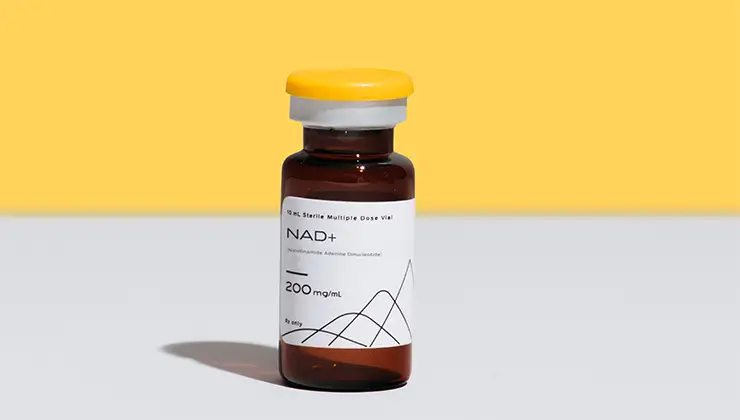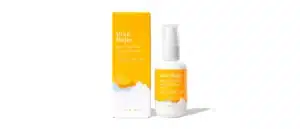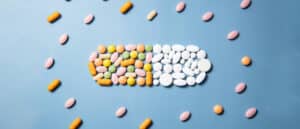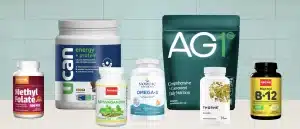This Buzzy Supplement May Help You Look and Feel Younger
- By Jennifer Chesak
- Medically reviewed by Kristen Fuller, M.D.
- June 20, 2022
Fast Facts
- NAD+ is a coenzyme found in every cell and is involved in hundreds of biological processes. NAD+ levels decline as we age.
- Declining NAD+ levels have been linked to a number of health issues such as metabolic disease, heart disease, and neurodegenerative diseases.
- While more research needs to be done, some studies suggest that NAD+ therapy can slow down the aging process and its related health issues.
Aging is one of those annoying facts of life. You can’t stop the clock or calendar from increasing the number of candles on your birthday cake. But while the mythical fountain of youth remains elusive, we can take steps to potentially prolong our vitality, increase our longevity, and even reduce the visual signs of aging. One supplement, called NAD+ has been gaining attention as a possible way to do this. So what’s the connection between NAD+ and aging?
Aging is a complex physiological disease. Medically speaking, aging is defined by a progressive decline in energy metabolism and physiological function, which serves as a major risk factor for several diseases such as cancer, cardiovascular disease, and neurodegenerative disease (1).
NAD+ is garnering some buzz as an anti-aging tool. We’re here to offer the nuts and bolts on nicotinamide adenine dinucleotide (yes, that’s a mouthful—hence the acronym). Let’s take a look at what this crucial coenzyme is all about (2).
What is NAD+?
NAD+ is a coenzyme in every cell in the body that plays a role in major biological processes in the body including:
- Cell metabolism (converting food into energy)
- DNA repair
- Immune function
- Cell signaling
- Immune function
- Mitochondria fitness (A decline in mitochondrial quality and activity is linked to normal aging and the development of a wide range of age-related diseases)
Levels of NAD+ steadily decline as we get up in years. That depletion leaves us ever more vulnerable to inflammation, various diseases, and changes in metabolic functioning (2).
We’ll avoid a full-scale biochemistry lesson here. But NAD exists in two forms: the molecules NAD+ and NADH. NAD+ is the oxidized form, while NADH is the reduced form (meaning extra hydrogen atoms or electrons).
Gaining or losing a hydrogen is known as a reduction and oxidative reaction respectively, as is commonly referred to as a “redox reaction.” These redox reactions often take place in the mitochondria during cellular respiration (turning food into energy), hence one reason why the mitochondria is an important component of aging.
Sometimes NAD+ is simply referred to as NAD when discussing the “chemical backbone” of the molecule, regardless of the molecule’s charge (2).
For the sake of simplicity, in this article, we’ll call it NAD+.
NAD+ in a Nutshell
- NAD+ is a coenzyme that that plays a role in hundred of major biological processes in the body.
- Levels of NAD+ steadily decline with age. This leaves you vulnerable to inflammation, diseases, and changes in metabolic functioning.
- NAD changes from NAD+ to NADH by gaining and losing electrons when your cells turn food into energy.
Where Does NAD+ Come From?
NAD+ can be made from multiple precursors (a compound that participates in a chemical reaction that produces another compound) via 3 different pathways.
Two pathway use the precursors nicotinic acid (NA), nicotinamide mononucleotide (NMN), nicotinamide (NAM) and nicotinamide riboside (NR), which are all part of the vitamin B3 family. The third pathway to make NAD+ uses tryptophan as the precursor. Tryptophan is an essential amino acid that plays many necessary roles in growth and development in the human body (3).
Why this is important: Understanding how NAD+ is made in the body and how it is broken down into a waste product allows researchers to study how to potentially slow down the aging process by either increasing the NAD + precursors or limiting NAD+ breakdown in hopes of slowing down the aging process (3).
NAD+ Breakdown
NAD+ is broken down by two main enzymes: poly (adenosine diphosphate-ribose) polymerases (PARPs) and CD38.
- PARP1 (the most common PARP) breaks down NAD+ when DNA is damaged in an effort to repair DNA that is damaged throughout the aging process (4).
- CD38 is a key player in many important physiological processes including immunity, inflammation, and glucose and lipid metabolism. An age-dependent increase in levels of CD38 protein has been reported in multiple tissues and organs, which as a result contributes to NAD+ decline (4).
How Is NAD+ Created and Broken Down
- NAD+ is created from precursors (compounds that create other compounds).
- NAD+ is broken down by two main enzymes.
- Understanding how NAD+ is made and broken down helps researchers study how to potentially slow down the aging process.
NAD and Aging
As you age, your body is more prone to inflammatory processes like arthritis, cognitive decline like dementia, sensory decline like hearing and vision loss, metabolic dysfunction like insulin resistance or high cholesterol, sexual or reproductive dysfunction like infertility, and changes in appearance like wrinkles. That’s a handful. Thankfully, science is on our side, always seeking ways to combat the aging process.
Research has shown that NAD+ levels decline as we age, directly affecting multiple tissues including:
- Liver
- Skeletal muscles
- Fat
- Heart
- Brain
- Kidneys
- Pancreas
- Spleen
- Skin
Through various animal studies and some preliminary human studies, researchers theorize that a decrease in NAD+ over time is why people develop age-realted diseases, dysfunctions, and even disabilities as we grow older (2, 5). In scientific models of aging, long-term administration of NAD+ precursors can protect against these age-associated disorders.
Administering NAD+precursors such as NMN has been shown to slow down the aging process by improving energy metabolism, insulin sensitivity, lipid metabolism, eye function, bone density and immune function.
Ultimately, boosting NAD+ may offer the following benefits (6):
- Protect the brain and nervous system
- Boost or protect cognitive function
- Promote healthier cholesterol and triglyceride levels
- Improve metabolic health markers
- Improve the health and functioning of various organs
- Reduce cardiovascular disease risk factors
NAD and the Aging Process
- As you age, declining NAD+ levels impact various tissues in the body.
- Researchers suspect declining NAD+ levels contributes to the development of age-related diseases.
- Boosting NAD+ may help protect the body from these age-related declines.
Can NAD+ Make You Look Younger?
The visual signs of aging can creep up. As we age, our skin loses elasticity, leading to those fine lines that deepen over time.
Skin goes through high cell turnover. For this reason, researchers say it requires higher concentrations of NAD+, which is crucial for DNA repair. In animal studies, lower amounts of NAD+ increase skin’s susceptibility to photoaging and damage from the sun. Researchers have determined that over the course of our adult lives, the concentration of NAD+ in our skin decreases by half, if not more (7).
NAD+ precursors—both in topical and oral form—may help combat the visual signs of aging (8). Studies in people show that topical nicotinamide (NAM, also called niacinamide)—which is an amide form of vitamin B3 and a precursor to NAD+—combats signs of aging, like wrinkles and dark spots. Oral NAM supplementation has been shown to be protective against some effects of UV radiation and reduces trans-epidermal water loss.
Topical NAD+ may combat visual signs of aging like wrinkles and dark spots.
Can NAD+ Help You live Longer?
Research shows that NAD+ decline promotes age-related disease processes, including cancer and cognitive issues. And supplementation with NAD+ precursors can help prevent or reduce the decrease in NAD+ levels, perhaps offering some protections against these diseases and dysfunctions. While there are no guarantees, by decreasing your risk for such diseases, you might improve your longevity (7).
A healthy metabolism is also associated with longevity, and NAD+ plays key roles in regulating metabolism. So theoretically, higher levels of NAD+ may lead to a longer life. But more research is needed as to whether NAD+ supplementation can increase your life expectancy (9).
Supplementing With NAD+
NAD+ is produced in the body from compounds called precursors. NAD+ precursors include various forms of vitamin B3 (also called niacin) and tryptophan, an amino acid (9). You can supplement with all of these.
You can also work with Hone to see if NAD+ injections are right for you. Simply create an account, then describe your symptoms and goals using Hone’s online form. A board-certified physician will review your answers, and prescribe NAD+ if appropriate. If your prescription is approved, NAD+ will be sent straight to your door.
NAD+ precursors
- Nicotinic acid (NA):The first human clinical test with oral Niacin (NA) had positive effects on patients with mitochondrial myopathy (diseases caused by damage to mitochondria). With a 10-month therapy, blood NAD+ levels increased up to 8-fold and muscle strength and mitochondrial re-growth improved in all subjects (10).
- Nicotinamide/niacinamide (NAM): Research shows that low doses, but not high doses, of NAM can increase lifespan in yeast and roundworms and has been shown to improve liver function, insulin and glucose levels, and inflammation in lab species with obesity.
- Nicotinamide riboside (NR): Research has shown that administration of NR can protect against aging and age-related diseases in laboratory animal models. In age-related disease, in particular obesity, diabetes, and heart conditions, NR has been shown to decrease weight gain, improve glucose tolerance and increase survival rates, respectively in rodents. NR has also been shown to improve memory, learning and motor function in rodents with neurodegenerative diseases such as Alzehimers and Parkison disease.
- Nicotinamide mononucleotide (NMN): Research has shown that administration of NMN in rodents increases the synthesis of NAD+ in various tissues including liver, pancreas, adipose tissue, brain, heart, skeletal muscle, kidney, eyes, and blood vessels (10, 11).
- Tryptophan (Trp): Although NAD+ can be made from the amino acid tryptophan, research is limited, if not absent, in terms of using tryptophan directly to synthesize NAD+ to reduce aging.

It should be. NAD+ may boost energy, increase lifespan, help with weight loss and improve brain function. Now available through Hone.
Increasing NAD+ via Supplements
- NAD+ is produced in the body from precursors.
- Supplementing with NAD+ precursors can help prevent or reduce age-related decreases in NAD+ levels.
NAD and Aging: What’s Next For Researchers
As we’ve covered, aging results in decreased NAD+. Changes in both the synthesis and consumption of NAD+ appear to deplete NAD+ pools in the body, which can lead to signs of aging. So far, early research has shown that by providing the precursors to NAD+ synthesis, aging could potentially be slowed down.
There are still many unknowns when it comes to NAD and aging. Despite the vast amount of research on NAD+ synthesis and its role in health and disease, there are major questions that are yet to be explored. Among them:
- What levels of NAD+ are associated with healthy aging and age-related diseases?
- Where is NAD+ localized in tissues and organs?
- Are NAD+ precursors safe and effective in people who have already developed age-related diseases?
The Bottom Line
NAD+ is a coenzyme present in all our cells. And it’s crucial for many biological processes. As we age, our level of NAD+ declines, making us more vulnerable to age-related diseases. More research needs to be done, but the possibility that supplementation with NAD+ precursors—in conjunction with healthy lifestyle factors—can be an anti-aging and longevity tool looks promising.
References:
1. Zhavoronkov A, et al (2015). Classifying aging as a disease in the context of ICD-11.
2. Mehmel M, Jovanović N, Spitz U (2020). Nicotinamide Riboside-The Current State of Research and Therapeutic Uses.
3. Rajman L, et al (2018). Therapeutic Potential of NAD-Boosting Molecules: The In Vivo Evidence.
4. Yahyah A. et al (2018). Therapeutic potential of boosting NAD+ in aging and age-related diseases.
5. Orlandi I, et al (2020). Nicotinamide, Nicotinamide Riboside and Nicotinic cid-Emerging Roles in Replicative and Chronological Aging in Yeast.
6. Yaku K, et al (2018). NAD metabolism: Implications in aging and longevity.
7. Katsyuba E, et al (2020). NAD+ homeostasis in health and disease.
8. McReynolds M, et al (2020). Age-related NAD+ decline.
9. Yaku K et al (2018). NAD metabolism: Implications in aging and longevity.
10. Poljsak B, Milisav I (2018). Vitamin B3 forms as precursors to NAD+: Are they safe?
11. Pirinen E, et al (2020). Niacin Cures Systemic NAD+ Deficiency and Improves Muscle Performance in Adult-Onset Mitochondrial Myopathy.












